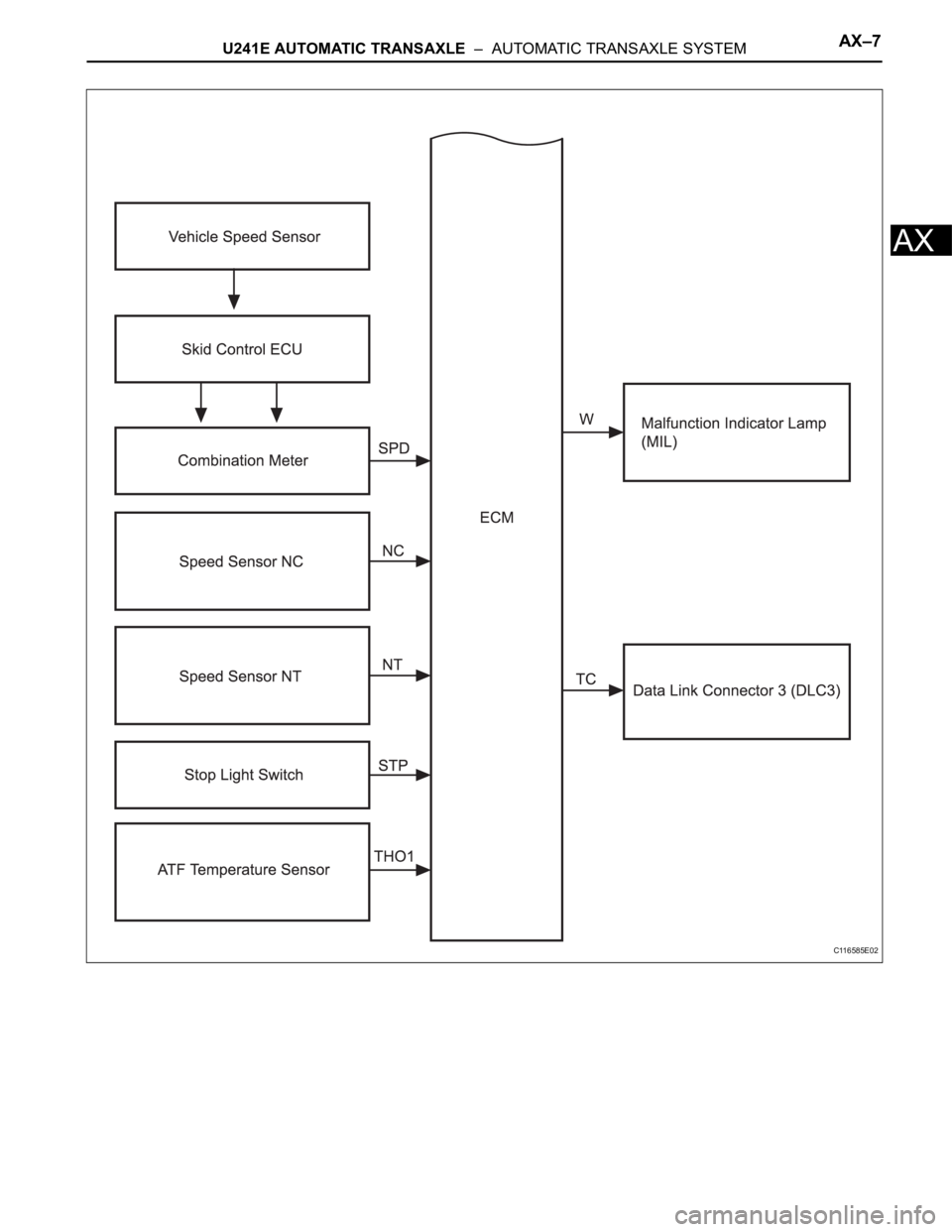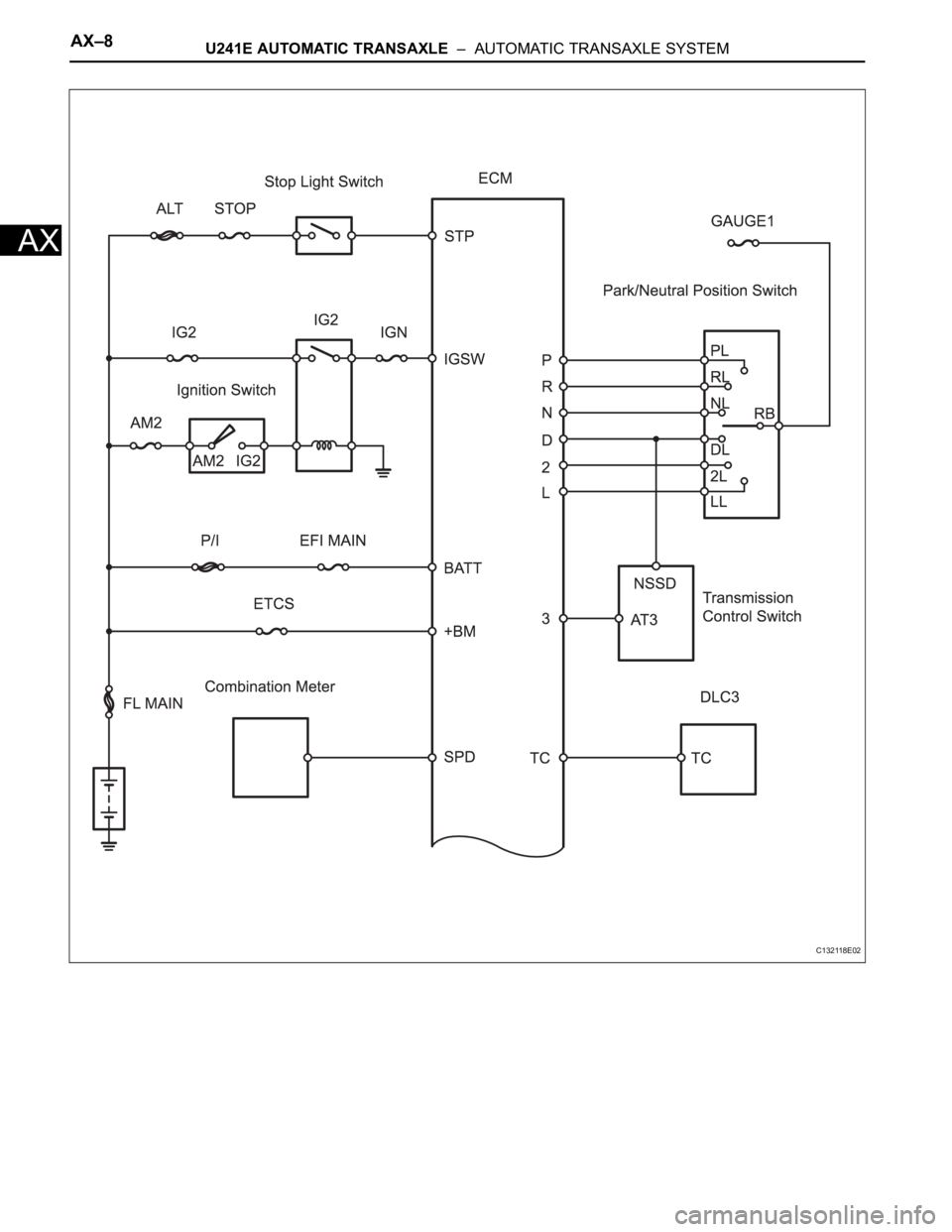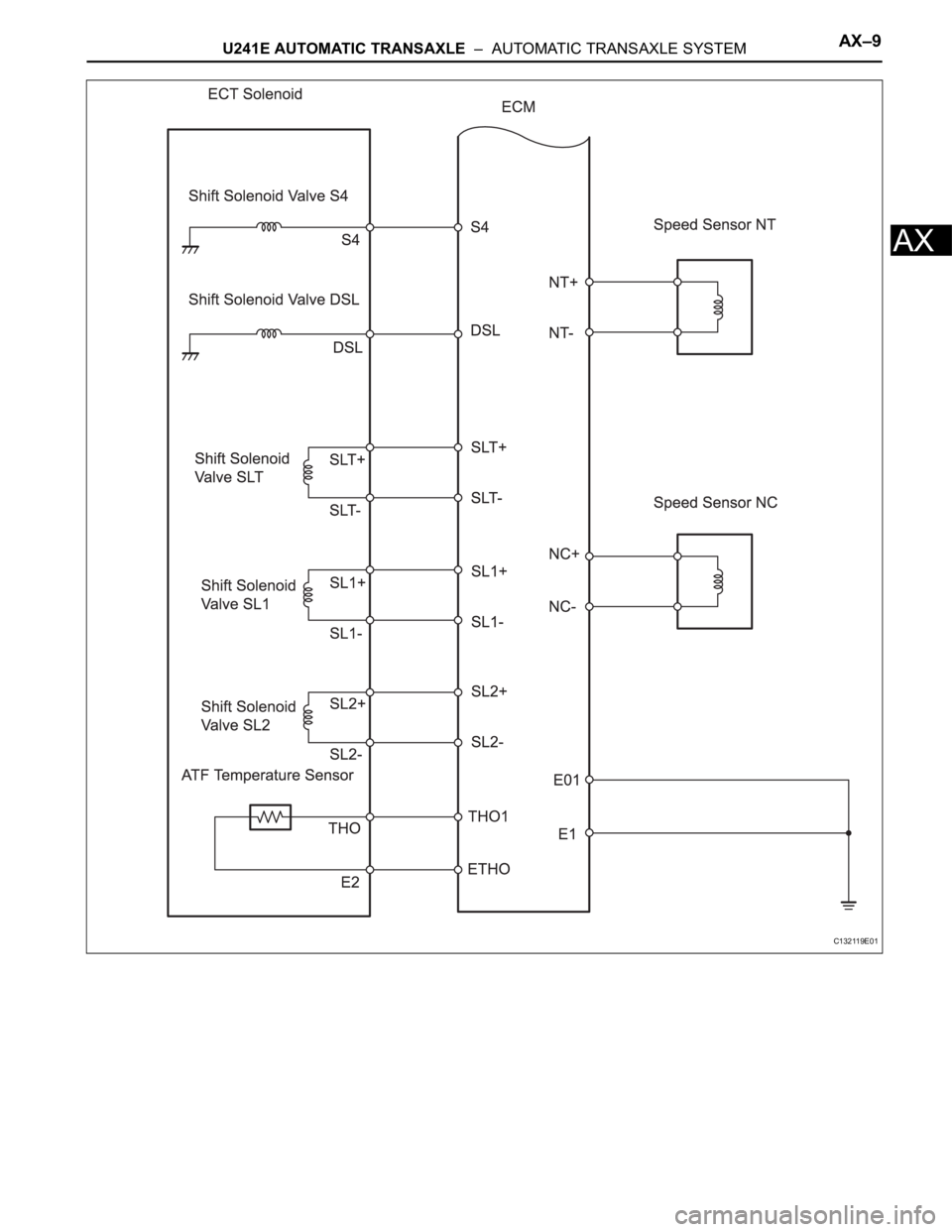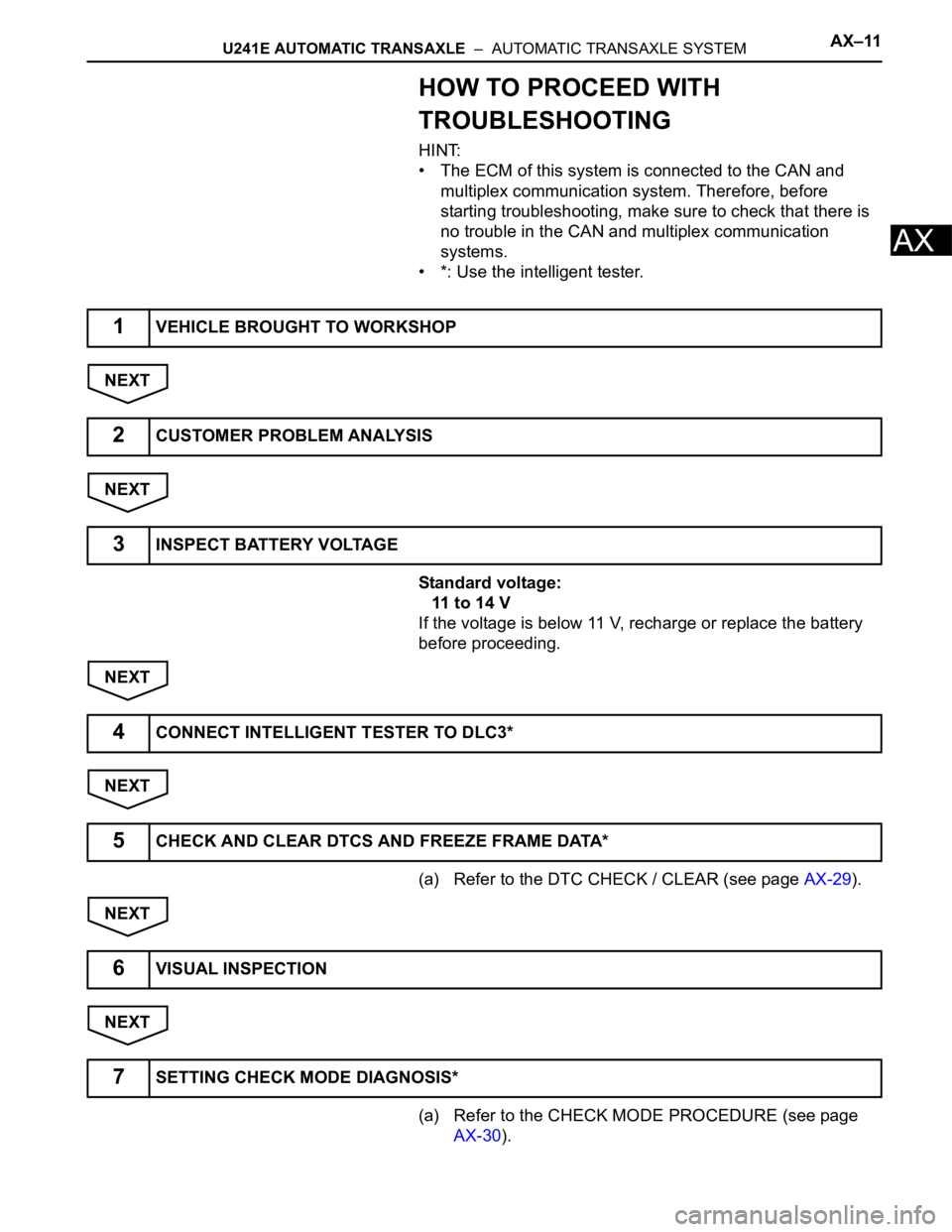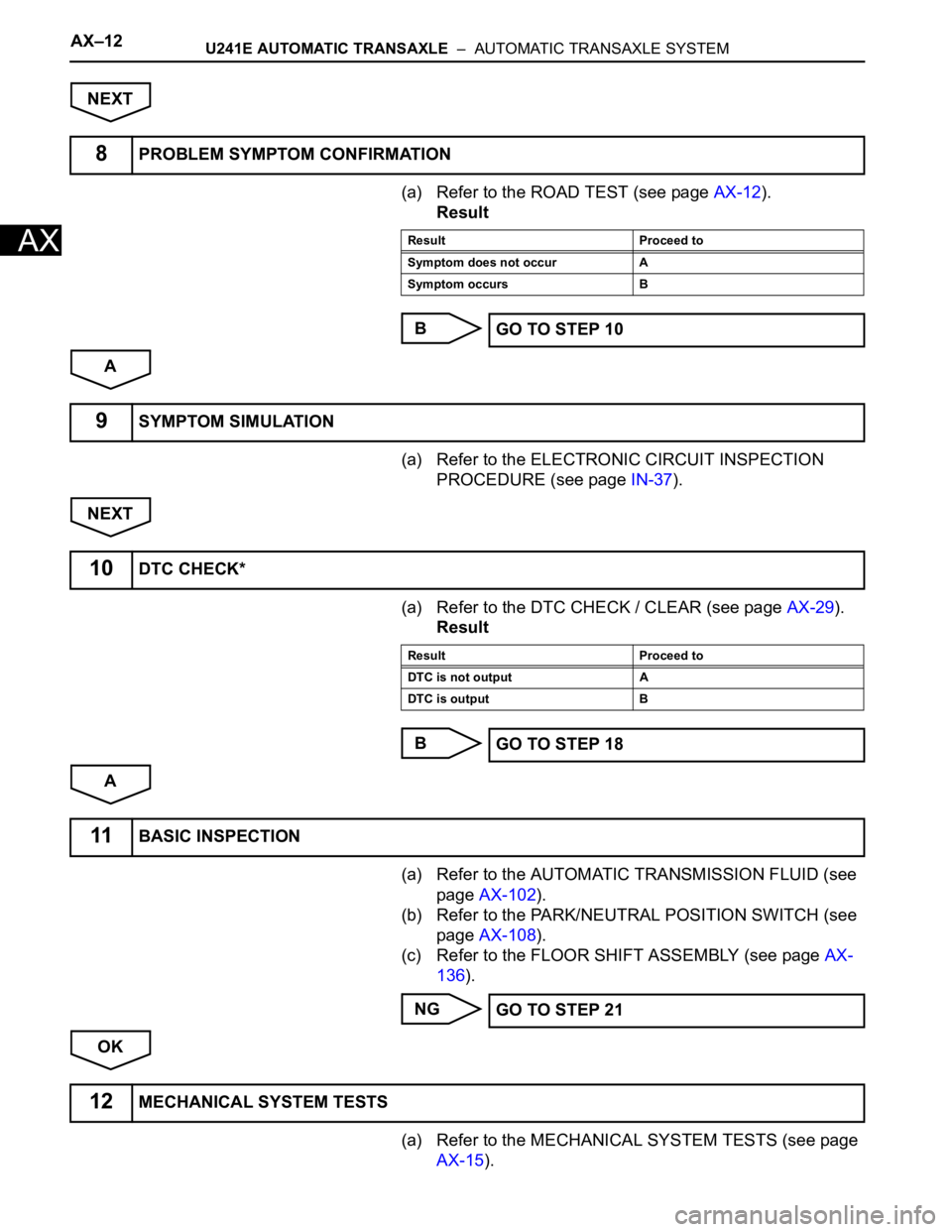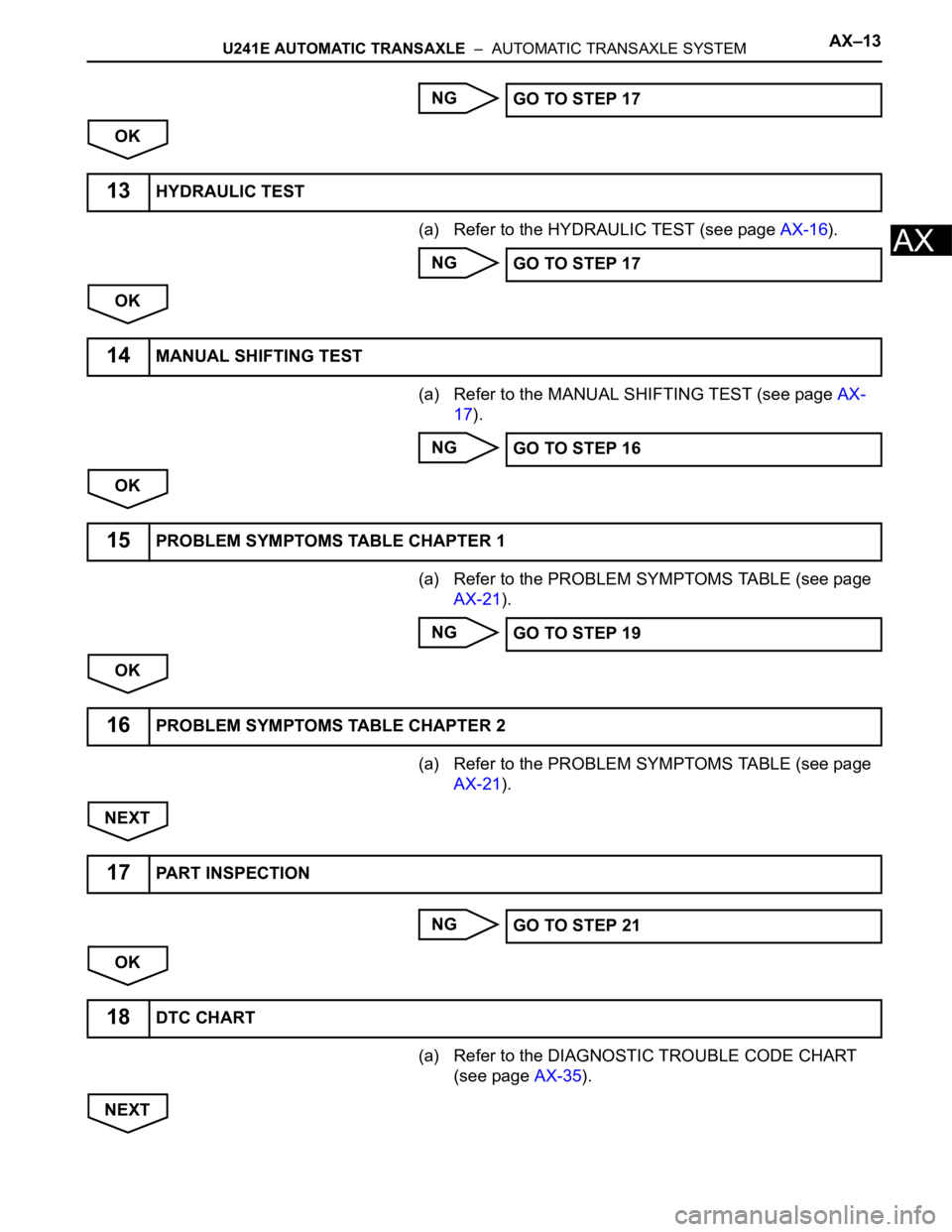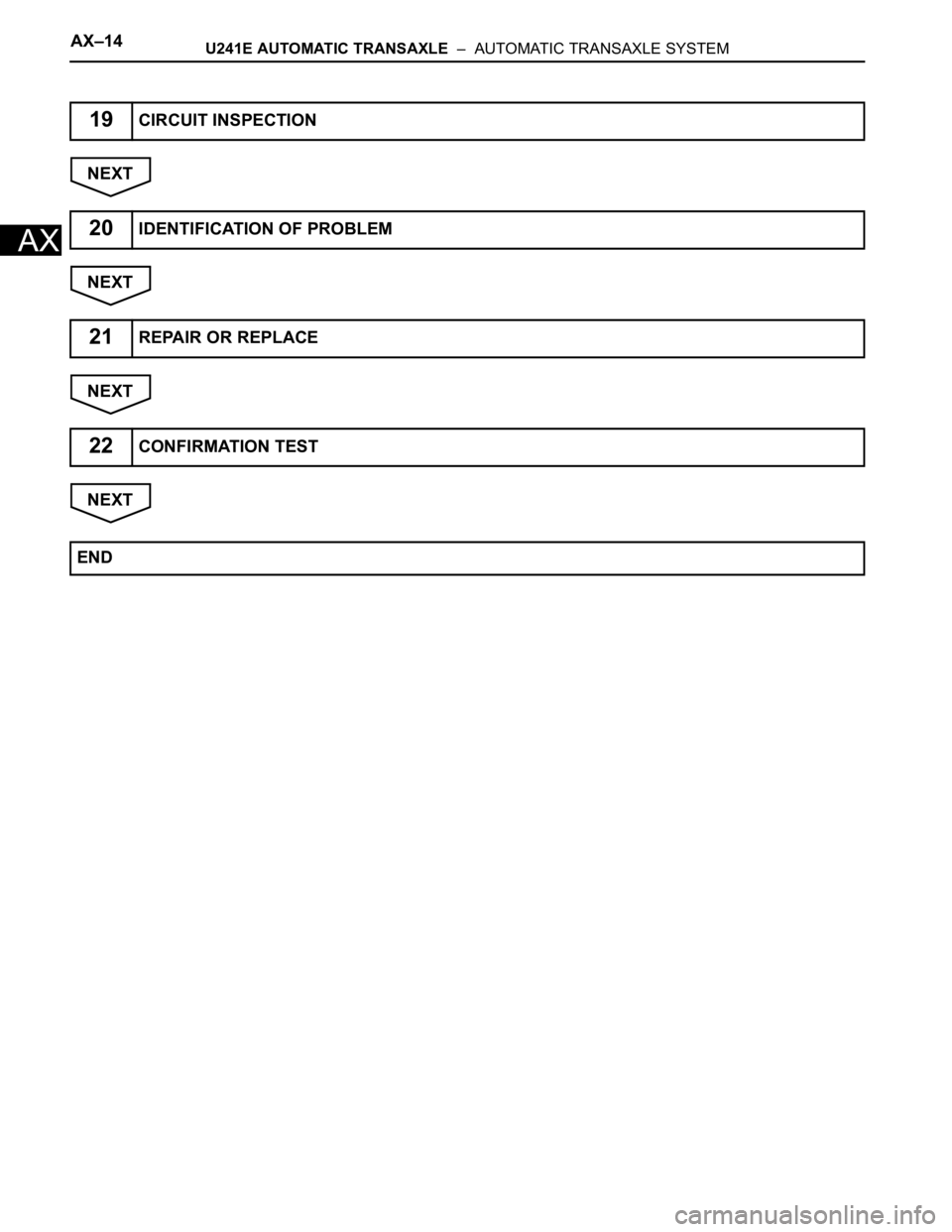TOYOTA RAV4 2006 Service Repair Manual
Manufacturer: TOYOTA, Model Year: 2006,
Model line: RAV4,
Model: TOYOTA RAV4 2006
Pages: 2000, PDF Size: 45.84 MB
TOYOTA RAV4 2006 Service Repair Manual
RAV4 2006
TOYOTA
TOYOTA
https://www.carmanualsonline.info/img/14/57463/w960_57463-0.png
TOYOTA RAV4 2006 Service Repair Manual
Trending: refrigeration system, airbag, set clock, snow chains, windshield wipers, heater, wiper blades
Page 1231 of 2000
U241E AUTOMATIC TRANSAXLE – AUTOMATIC TRANSAXLE SYSTEMAX–7
AX
C116585E02
Page 1232 of 2000
AX–8U241E AUTOMATIC TRANSAXLE – AUTOMATIC TRANSAXLE SYSTEM
AX
C132118E02
Page 1233 of 2000
U241E AUTOMATIC TRANSAXLE – AUTOMATIC TRANSAXLE SYSTEMAX–9
AX
C132119E01
Page 1234 of 2000
AX–10U241E AUTOMATIC TRANSAXLE – AUTOMATIC TRANSAXLE SYSTEM
AX
SYSTEM DESCRIPTION
1. SYSTEM DESCRIPTION
(a) The Electronic Controlled Automatic Transaxle
(ECT) is an automatic transaxle that electronically
controls shift timing using the Engine Control
Module (ECM). The ECM detects electrical signals
that indicate engine and driving conditions, and
controls the shift point based on driver habits and
road conditions. As a result, fuel efficiency and
power transaxle performance are improved.
Shift shock is reduced by controlling the engine and
transaxle simultaneously.
In addition, the ECT has the following features:
• Diagnostic function.
• Fail-safe function when a malfunction occurs.
Page 1235 of 2000
U241E AUTOMATIC TRANSAXLE – AUTOMATIC TRANSAXLE SYSTEMAX–11
AX
HOW TO PROCEED WITH
TROUBLESHOOTING
HINT:
• The ECM of this system is connected to the CAN and
multiplex communication system. Therefore, before
starting troubleshooting, make sure to check that there is
no trouble in the CAN and multiplex communication
systems.
• *: Use the intelligent tester.
NEXT
NEXT
Standard voltage:
11 to 14 V
If the voltage is below 11 V, recharge or replace the battery
before proceeding.
NEXT
NEXT
(a) Refer to the DTC CHECK / CLEAR (see page AX-29).
NEXT
NEXT
(a) Refer to the CHECK MODE PROCEDURE (see page
AX-30).
1VEHICLE BROUGHT TO WORKSHOP
2CUSTOMER PROBLEM ANALYSIS
3INSPECT BATTERY VOLTAGE
4CONNECT INTELLIGENT TESTER TO DLC3*
5CHECK AND CLEAR DTCS AND FREEZE FRAME DATA*
6VISUAL INSPECTION
7SETTING CHECK MODE DIAGNOSIS*
Page 1236 of 2000
AX–12U241E AUTOMATIC TRANSAXLE – AUTOMATIC TRANSAXLE SYSTEM
AX
NEXT
(a) Refer to the ROAD TEST (see page AX-12).
Result
B
A
(a) Refer to the ELECTRONIC CIRCUIT INSPECTION
PROCEDURE (see page IN-37).
NEXT
(a) Refer to the DTC CHECK / CLEAR (see page AX-29).
Result
B
A
(a) Refer to the AUTOMATIC TRANSMISSION FLUID (see
page AX-102).
(b) Refer to the PARK/NEUTRAL POSITION SWITCH (see
page AX-108).
(c) Refer to the FLOOR SHIFT ASSEMBLY (see page AX-
136).
NG
OK
(a) Refer to the MECHANICAL SYSTEM TESTS (see page
AX-15).
8PROBLEM SYMPTOM CONFIRMATION
Result Proceed to
Symptom does not occur A
Symptom occurs B
GO TO STEP 10
9SYMPTOM SIMULATION
10DTC CHECK*
Result Proceed to
DTC is not output A
DTC is output B
GO TO STEP 18
11BASIC INSPECTION
GO TO STEP 21
12MECHANICAL SYSTEM TESTS
Page 1237 of 2000
U241E AUTOMATIC TRANSAXLE – AUTOMATIC TRANSAXLE SYSTEMAX–13
AX
NG
OK
(a) Refer to the HYDRAULIC TEST (see page AX-16).
NG
OK
(a) Refer to the MANUAL SHIFTING TEST (see page AX-
17).
NG
OK
(a) Refer to the PROBLEM SYMPTOMS TABLE (see page
AX-21).
NG
OK
(a) Refer to the PROBLEM SYMPTOMS TABLE (see page
AX-21).
NEXT
NG
OK
(a) Refer to the DIAGNOSTIC TROUBLE CODE CHART
(see page AX-35).
NEXTGO TO STEP 17
13HYDRAULIC TEST
GO TO STEP 17
14MANUAL SHIFTING TEST
GO TO STEP 16
15PROBLEM SYMPTOMS TABLE CHAPTER 1
GO TO STEP 19
16PROBLEM SYMPTOMS TABLE CHAPTER 2
17PART INSPECTION
GO TO STEP 21
18DTC CHART
Page 1238 of 2000
AX–14U241E AUTOMATIC TRANSAXLE – AUTOMATIC TRANSAXLE SYSTEM
AX
NEXT
NEXT
NEXT
NEXT
19CIRCUIT INSPECTION
20IDENTIFICATION OF PROBLEM
21REPAIR OR REPLACE
22CONFIRMATION TEST
END
Page 1239 of 2000

U241E AUTOMATIC TRANSAXLE – AUTOMATIC TRANSAXLE SYSTEMAX–15
AX
ROAD TEST
1. PROBLEM SYMPTOM CONFIRMATION
(a) Based on the result of the customer problem
analysis, try to reproduce the symptoms. If the
problem is that the transaxle does not shift up, shift
down, or the shift point is too high or too low,
conduct the following road test referring to the
automatic shift schedule and simulate the problem
symptoms.
2. ROAD TEST
NOTICE:
Perform the test at the normal operating ATF
temperature of 50 to 80
C (122 to 176F).
(a) D position test
Move the shift lever to D and fully depress the
accelerator pedal. Check the following:
(1) Check up-shift operation.
Check that the 1
2, 2 3 and 3 O/D up-
shifts take place at the shift point shown in the
automatic shift schedule (see page SS-60).
HINT:
O/D Gear Up-shift Prohibition Control
• Engine coolant temperature is 55
C (131F)
or less and vehicle speed is at 70 km/h (43
mph) or less.
• ATF temperature is 5
C (41F) or less.
O/D Gear Lock-up Prohibition Control
• Brake pedal is depressed.
• Accelerator pedal is released.
• Engine coolant temperature is 60
C (140F)
or less.
(2) Check for shift shock and slip.
Check for shock and slip at the 1
2, 2 3 and
3
O/D up-shifts.
(3) Check for abnormal noise and vibration.
Check for abnormal noise and vibration when
up-shifting from 1
2, 2 3 and 3 O/D while
driving with the shift lever on D, and check while
driving in the lock-up condition.
HINT:
The check for the cause of abnormal noise and
vibration must be done thoroughly as it could
also be due to loss of balance in the differential,
torque converter clutch, etc.
(4) Check kick-down operation.
While driving the vehicle in the 2nd, 3rd and O/D
gears with the shift lever on D, check that the
possible kick-down vehicle speed limits for 2
1, 3
2 and O/D 3 kick-downs conform to
those indicated in the automatic shift schedule
(see page SS-60).
(5) Check for abnormal shock and slip at kick-down.
Page 1240 of 2000

AX–16U241E AUTOMATIC TRANSAXLE – AUTOMATIC TRANSAXLE SYSTEM
AX
(6) Check the lock-up mechanism.
• Drive the vehicl e in the O/D gear with the shift
lever on D. Maintain a steady speed (lock-up
ON).
• Lightly depress the accelerator pedal and
check that the engine speed does not change
abruptly.
HINT:
• There is no lock-up function in the 1st and
2nd gear.
• If there is a sudden increase in engine speed,
there is no lock-up.
(b) 3 position test
Move the shift lever to 3 and fully depress the
accelerator pedal. Check the following:
(1) Check up-shift operation.
Check that the 1
2 and 2 3 up-shifts take
place and that the shift point conforms to the
automatic shift schedule (see page SS-60).
(2) Check engine braking.
While driving the vehicle in the 3rd gear with the
shift lever on 3, release the accelerator pedal
and check the engine braking effect.
(3) Check for abnormal noises during acceleration
and deceleration, and for shock at up-shift and
down-shift.
(c) 2 position test
Move the shift lever to 2 and fully depress the
accelerator pedal. Check the following:
(1) Check up-shift operation.
Check that the 1
2 up-shift takes place and
that the shift point conforms to the automatic
shift schedule (see page SS-60).
HINT:
There is no O/D up-shift and lock-up when the
shift lever is on 2.
(2) Check engine braking.
While driving the vehicle in the 2nd gear with the
shift lever on 2, release the accelerator pedal
and check the engine braking effect.
(3) Check for abnormal noises during acceleration
and deceleration, and for shock at up-shift and
down-shift.
(d) L position test
Move the shift lever to L and fully depress the
accelerator pedal. Check the following:
(1) Check that there is no up-shift.
While driving the vehicle with the shift lever on L,
check that there is no up-shift to 2nd gear.
HINT:
There is no lock-up in L.
Trending: wheel torque, differential, transfer, diagram, wiring diagram, center console, maintenance
